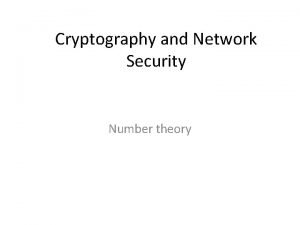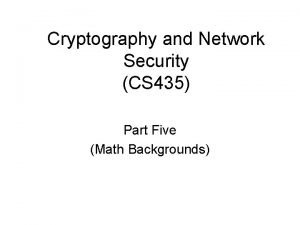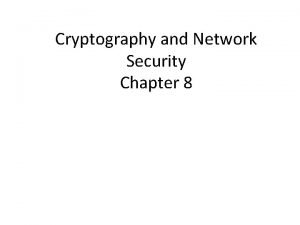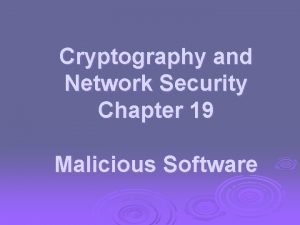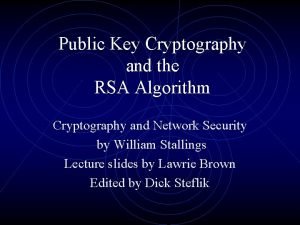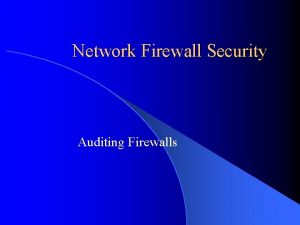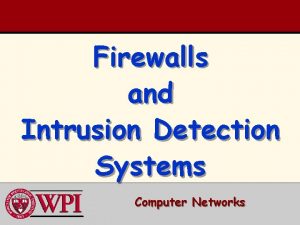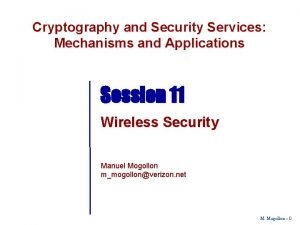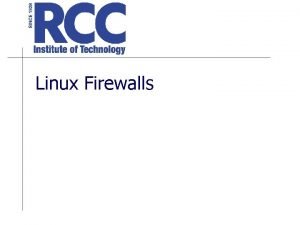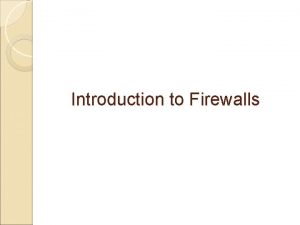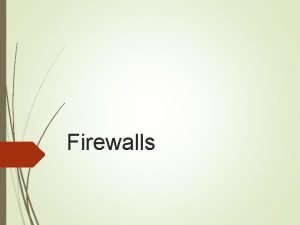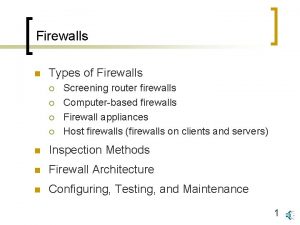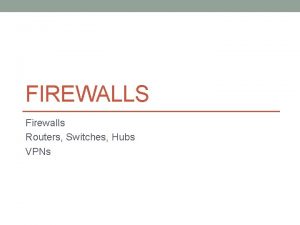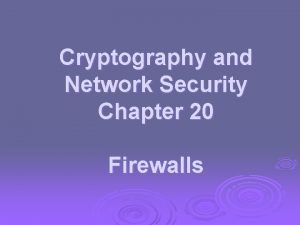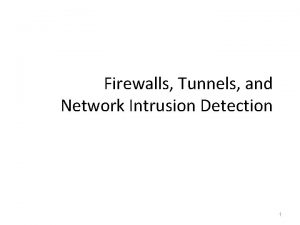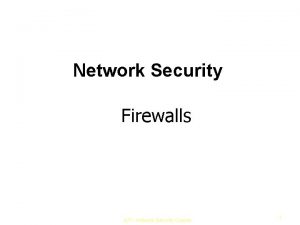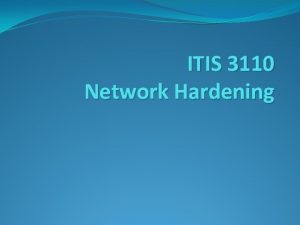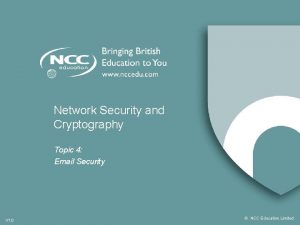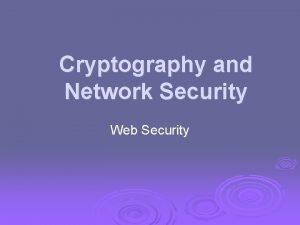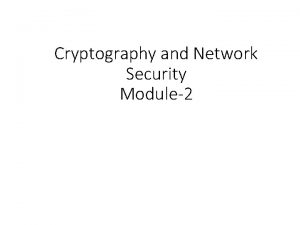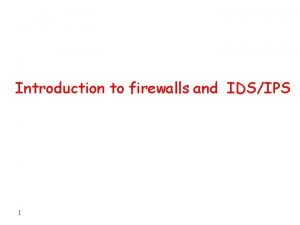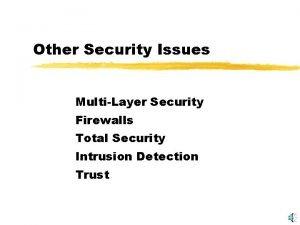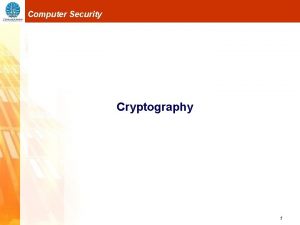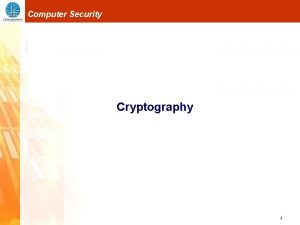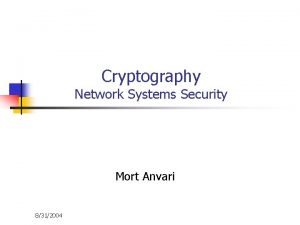Network Security and Cryptography Topic 9 Firewalls V






































- Slides: 38

Network Security and Cryptography Topic 9: Firewalls V 1. 0 © NCC Education Limited

Network Security and Cryptography Topic 9 – Lecture 1: Firewall Operation V 1. 0 © NCC Education Limited

Firewalls Topic 9 - 9. 3 Scope and Coverage This topic will cover: • Firewall architectures and their limitations • The DMZ firewall and its limitations V 1. 0 © NCC Education Limited

Firewalls Topic 9 - 9. 4 Learning Outcomes By the end of this topic students will be able to: • Describe the components of a firewall • Configure a DMZ firewall • Evaluate the limitations of firewalls V 1. 0 © NCC Education Limited

Firewalls Topic 9 - 9. 5 Network Firewall • A firewall is the first line of defence for your network • The purpose of a firewall is to keep intruders from gaining access to your network • Usually placed at the perimeter of network to act as a gatekeeper for incoming and outgoing traffic • It protects your computer from Internet threats by erecting a virtual barrier between your network or computer and the Internet V 1. 0 © NCC Education Limited

Firewalls Topic 9 - 9. 6 How Does a Firewall Work? • Examines the traffic sent between two networks - e. g. examines the traffic being sent between your network and the Internet • Data is examined to see if it appears legitimate: - if so the data is allowed to pass through - If not, the data is blocked • A firewall allows you to establish certain rules to determine what traffic should be allowed in or out of your private network V 1. 0 © NCC Education Limited

Firewalls Topic 9 - 9. 7 Creating Rules • Traffic blocking rules can be based upon: - Words or phrases Domain names IP addresses Ports Protocols (e. g. FTP) • While firewalls are essential, they can block legitimate transmission of data and programs V 1. 0 © NCC Education Limited

Firewalls Topic 9 - 9. 8 Common Firewall Types • In general there are software firewalls and hardware firewalls - Even in home networks • Hardware firewalls are typically found in routers, which distribute incoming traffic from an Internet connection to computers • Software firewalls reside in individual computers • Ideally a network has both V 1. 0 © NCC Education Limited

Firewalls Topic 9 - 9. 9 Software Firewall • Protect only the computer on which they are installed • Provide excellent protection against threats (viruses, worms, etc. ) • Have a user-friendly interface • Have flexible configuration V 1. 0 © NCC Education Limited

Firewalls Topic 9 - 9. 10 Router Firewall • Protect your entire network or part of a network • Located on your router • Protect network hardware which cannot have a software firewall installed on it • Allows the creation of network-wide rules that govern all computers on the network V 1. 0 © NCC Education Limited

Firewalls Topic 9 - 9. 11 Firewall Operation • Can be divided into three main methods: - Packet filters (see last topic) - Application gateways - Packet inspection • Individual vendors of firewalls may provide additional features - You should look at their products for details V 1. 0 © NCC Education Limited

Firewalls Topic 9 - 9. 12 Application Gateways • Application-layer firewalls can understand the traffic flowing through them and allow or deny traffic based on the content • Host-based firewalls designed to block objectionable Web content based on keywords are a form of application-layer firewall • Application-layer firewalls can inspect packets bound for an internal Web server to ensure the request isn’t really an attack in disguise V 1. 0 © NCC Education Limited

Firewalls Topic 9 - 9. 13 Advantages of Application Gateways • Provide a buffer from port scans and application attacks - if an attacker finds a vulnerability in an application, the attacker would have to compromise the application/proxy firewall before attacking devices behind the firewall • Can be patched quickly in the event of a vulnerability being discovered - This may not be true for patching all the internal devices V 1. 0 © NCC Education Limited

Firewalls Topic 9 - 9. 14 Disadvantages • Needs to know how to handle traffic to and from your specific application - If you have an application that's unique, your application layer firewall may not be able to support it without making some significant modifications • Application firewalls are generally much slower than packet-filtering or packet-inspection firewalls - They run applications, maintain state for both the client and server, and also perform inspection of traffic V 1. 0 © NCC Education Limited

Firewalls Topic 9 - 9. 15 Packet Inspection Firewalls • Examine the session information between devices: - V 1. 0 Protocol New or existing connection Source IP address Destination IP address Port numbers IP checksum Sequence numbers Application-specific information © NCC Education Limited

Firewalls Topic 9 - 9. 16 Outbound Internet Traffic • Client initiates connection to IP address of the web server destined for port 80 (HTTP) • Firewall determines whether that packet is allowed through the firewall based on the current rule-set • Firewall looks into the data portion of the IP packet and determine whether it is legitimate HTTP traffic • If all the requirements are met, a flow entry is created in the firewall based on the session information, and that packet is allowed to pass V 1. 0 © NCC Education Limited

Firewalls Topic 9 - 9. 17 Inbound Internet Traffic • Web server receives the packet and responds • Return traffic is received by the firewall • Firewall determines if return traffic is allowed by comparing the session information with the information contained in the local translation table • If return traffic matches the previous requirements, payload is inspected to validate appropriate HTTP • Then it is forwarded to the client V 1. 0 © NCC Education Limited

Firewalls Topic 9 - 9. 18 Advantages • Generally much faster than application firewalls - They are not required to host client applications • Most of the packet-inspection firewalls today also offer deep-packet inspection - The firewall can dig into the data portion of the packet and also: - Match on protocol compliance - Scan for viruses - Still operate very quickly V 1. 0 © NCC Education Limited

Firewalls Topic 9 - 9. 19 Disadvantages • Open to certain denial-of-service attacks • These can be used to fill the connection tables with illegitimate connections V 1. 0 © NCC Education Limited

Network Security and Cryptography Topic 9 – Lecture 2: Firewall Architecture V 1. 0 © NCC Education Limited

Firewalls Topic 9 - 9. 21 Firewall Architecture • Firewalls are used to protect the perimeter of a network and the perimeter of sections of networks • A key question for a network administrator is where firewalls should be located • The positioning of firewalls in relation to other network elements is the firewall architecture • We will only look at the position of firewalls and the consequences of this - Other security devices should also be used V 1. 0 © NCC Education Limited

Firewalls Topic 9 - 9. 22 Firewall Architecture • The following are common firewall architectures: - V 1. 0 Screening router Screened host Dual homed host Screened subnet with multiple DMZs Dual firewall © NCC Education Limited

Firewalls Topic 9 - 9. 23 Screening Router • Simplest of firewall architectures • Traffic is screened by a router - Packet filtering - Using ACLs • Traffic is screened according to: - Source or destination IP address - Transport layer protocol - Services requested V 1. 0 © NCC Education Limited

Firewalls Topic 9 - 9. 24 Screening Router • Usually deployed at the perimeter of the network • May be used to control access to a Demilitarized Zone (DMZ) – see later • More often used in conjunction with other firewall technologies V 1. 0 © NCC Education Limited

Firewalls Topic 9 - 9. 25 Advantages & Disadvantages • Advantages - Simple - Cheap • Disadvantages - No logging - No user authentication - Difficult to hide internal network structure V 1. 0 © NCC Education Limited

Firewalls Topic 9 - 9. 26 Demilitarised Zones (DMZ) • A DMZ is part of the internal network but separated from the rest of the internal network • Traffic moving between the DMZ and other interfaces on the protected side of the firewall still goes through the firewall • This traffic has firewall protection policies applied • Common to put public-facing servers on the DMZ: - Web servers - Email servers V 1. 0 © NCC Education Limited

Firewalls Topic 9 - 9. 27 Demilitarised Zones (DMZ) V 1. 0 © NCC Education Limited

Firewalls Topic 9 - 9. 28 Screened Host Firewall • Adds an extra layer of protection in comparison to a screening router • Has a Bastion Host/Firewall between networks • Bastion Host/Firewall has two NICs • Bastion Host/Firewall connects the trusted network to the untrusted network - Stateful and proxy technologies are used to filter traffic up to the application layer V 1. 0 © NCC Education Limited

Firewalls Topic 9 - 9. 29 Bastion Host • A special purpose computer specifically designed and configured to withstand attacks • The router is the first line of defence - packet filtering/access control is carried out at the router • The bastion host is the server that connects to the unsecure network through the router V 1. 0 © NCC Education Limited

Firewalls Topic 9 - 9. 30 Advantages & Disadvantages • Advantages - Security is distributed between two points - Greater security than screening router - Transparent outbound access/restricted inbound access • Disadvantages - Difficult to hide internal structure - There is a single point of failure in the network V 1. 0 © NCC Education Limited

Firewalls Topic 9 - 9. 31 Dual-Homed Host • A Bastion Host/Firewall is surrounded with packet filtering routers - Dual-homed - outside world and protected network - Multi-homed - outside world and multiple protected networks • Routers filter traffic to the Bastion Host • Bastion Host adds additional filtering capabilities • Bastion Host has no routing capabilities V 1. 0 © NCC Education Limited

Firewalls Topic 9 - 9. 32 Advantages & Disadvantages • Advantages - Hides internal network structure • Disadvantages - Requires users to log onto bastion host or the use of proxy servers V 1. 0 © NCC Education Limited

Firewalls Topic 9 - 9. 33 Screened Subnet DMZ • Bastion Host is surrounded with packet filtering routers • These control traffic into and out of the trusted and untrusted network sections • Has an extra layer of functionality with a DMZ • Traffic from DMZ to trusted network must go through Bastion Host and packet filtering router V 1. 0 © NCC Education Limited

Firewalls Topic 9 - 9. 34 Advantages & Disadvantages • Advantages - Provides services to outside without compromising inside - Internal network hidden • Disadvantages - Single point of failure V 1. 0 © NCC Education Limited

Firewalls Topic 9 - 9. 35 Screened Subnet Multiple DMZs • Allows configuration of varying levels of security between: - DMZs and the untrusted network - Different DMZs - DMZs and the trusted network V 1. 0 © NCC Education Limited

Firewalls Topic 9 - 9. 36 Dual Firewall Architecture • Using two or more firewalls enhances security • Can be used to create DMZs • Using technology from multiple vendors can enhance security V 1. 0 © NCC Education Limited

Firewalls Topic 9 - 9. 37 References • Scambrey, J. , Mc. Clure, S. and Kurtz, J. (2001). Hacking Exposed: Network Security Secrets & Solutions, 2 nd Edition. Mc. Graw Hill. • Zwicky, E. D. (2000). Building Internet Firewalls, 2 nd Edition. O’Reilly Media. V 1. 0 © NCC Education Limited

Firewalls Topic 9 - 9. 38 Topic 9 – Firewalls Any Questions? V 1. 0 © NCC Education Limited
 Wireless security in cryptography
Wireless security in cryptography Cryptography and network security 6th edition
Cryptography and network security 6th edition Introduction to network security and cryptography
Introduction to network security and cryptography Number theory in cryptography and network security
Number theory in cryptography and network security Firewall in cryptography and network security
Firewall in cryptography and network security Authentication in cryptography and network security
Authentication in cryptography and network security Intruders in network security
Intruders in network security What is primitive root in cryptography
What is primitive root in cryptography Cryptography and network security 6th edition pdf
Cryptography and network security 6th edition pdf Cryptography and network security pearson
Cryptography and network security pearson Euler's theorem in cryptography and network security
Euler's theorem in cryptography and network security Cryptography and network security 4th edition
Cryptography and network security 4th edition Euler's theorem in cryptography and network security
Euler's theorem in cryptography and network security Finite fields in cryptography and network security
Finite fields in cryptography and network security Dsa in network security
Dsa in network security Modular arithmetic in cryptography and network security
Modular arithmetic in cryptography and network security Pgp in cryptography and network security
Pgp in cryptography and network security Euler's theorem in cryptography and network security
Euler's theorem in cryptography and network security Malicious software in cryptography
Malicious software in cryptography Introduction to cryptography and network security
Introduction to cryptography and network security Rsa algorithm in cryptography and network security
Rsa algorithm in cryptography and network security Introduction to cryptography and network security
Introduction to cryptography and network security Auditing firewalls
Auditing firewalls Firewalls are used for what security principle
Firewalls are used for what security principle Private secruity
Private secruity Cryptography security services
Cryptography security services Firewalls and intrusion detection systems
Firewalls and intrusion detection systems What is the osi security architecture?
What is the osi security architecture? Security guide to network security fundamentals
Security guide to network security fundamentals Electronic mail security in network security
Electronic mail security in network security Security guide to network security fundamentals
Security guide to network security fundamentals Security guide to network security fundamentals
Security guide to network security fundamentals Cryptography security services
Cryptography security services Pigpen
Pigpen How to write a clincher sentence
How to write a clincher sentence Tapic about internet
Tapic about internet Linux kernel history
Linux kernel history Introduction to firewalls
Introduction to firewalls Stateful firewall vs stateless
Stateful firewall vs stateless












